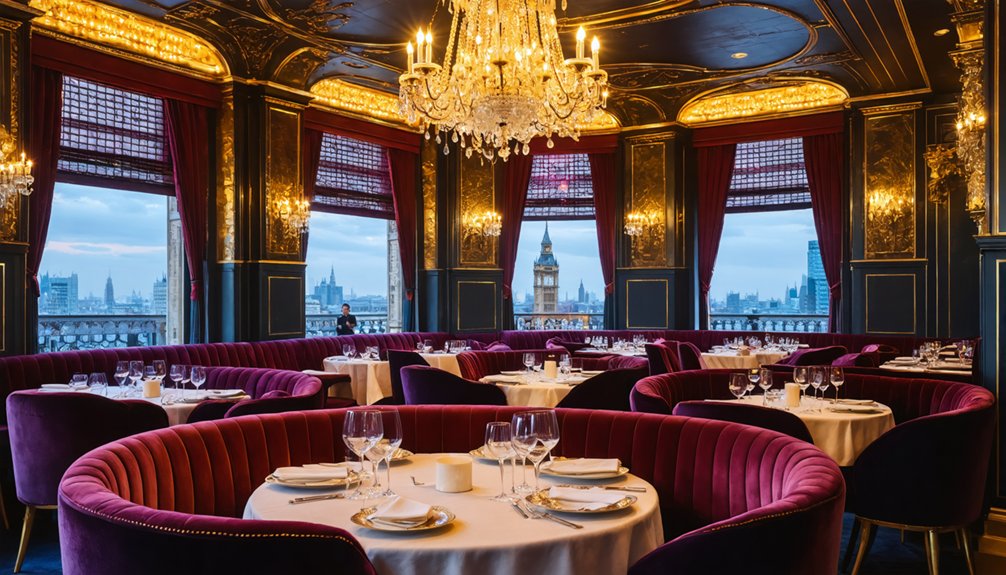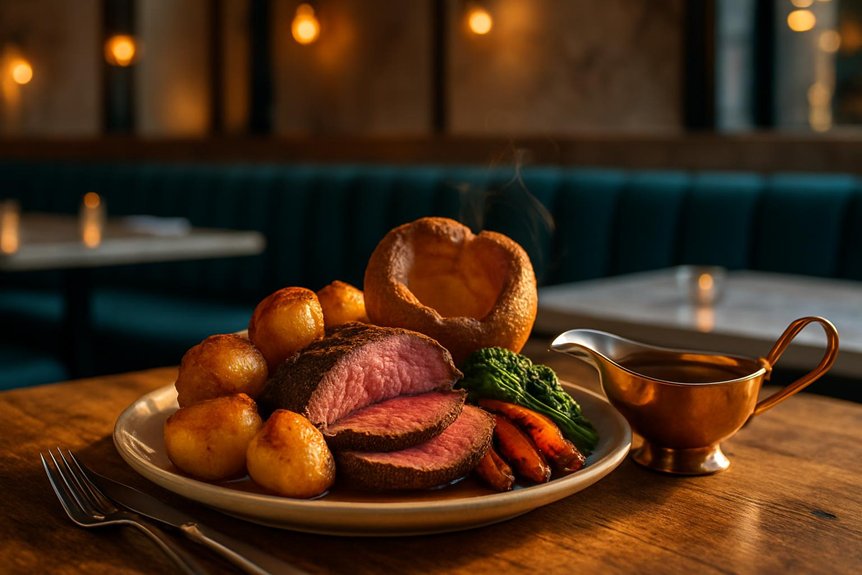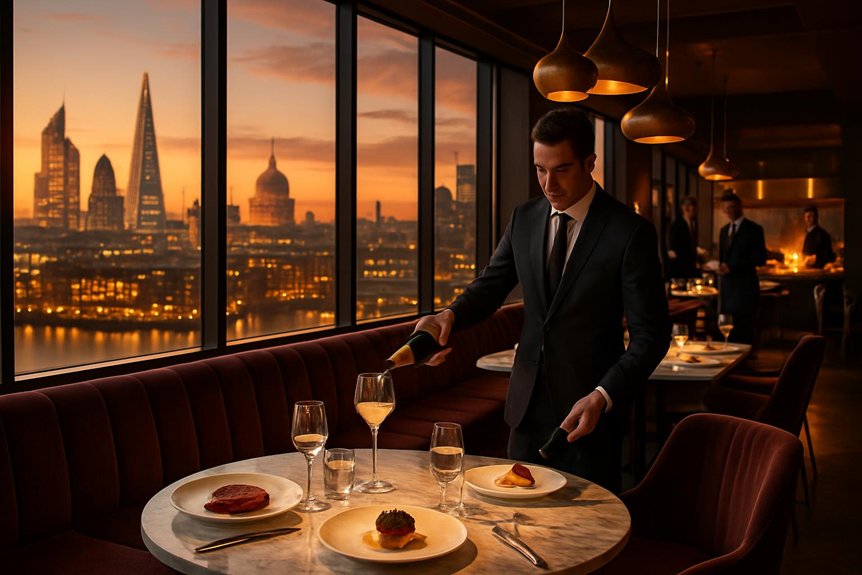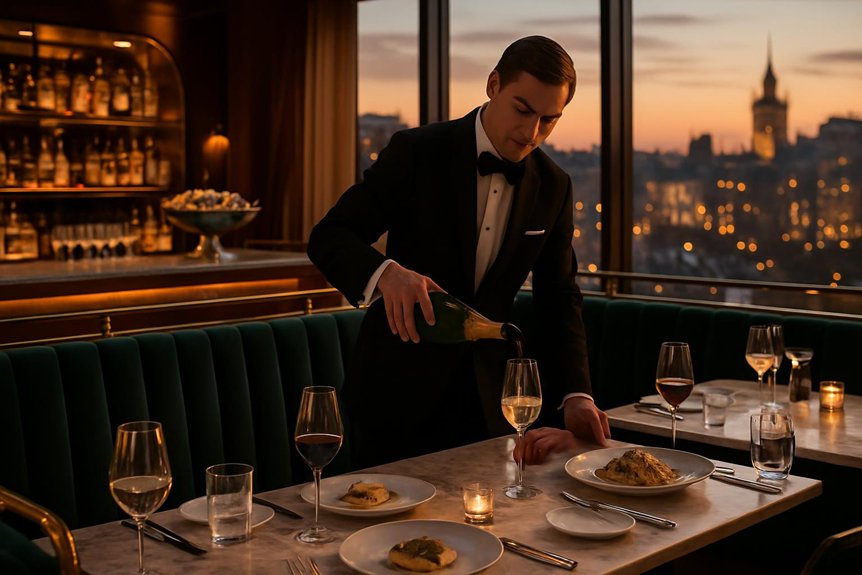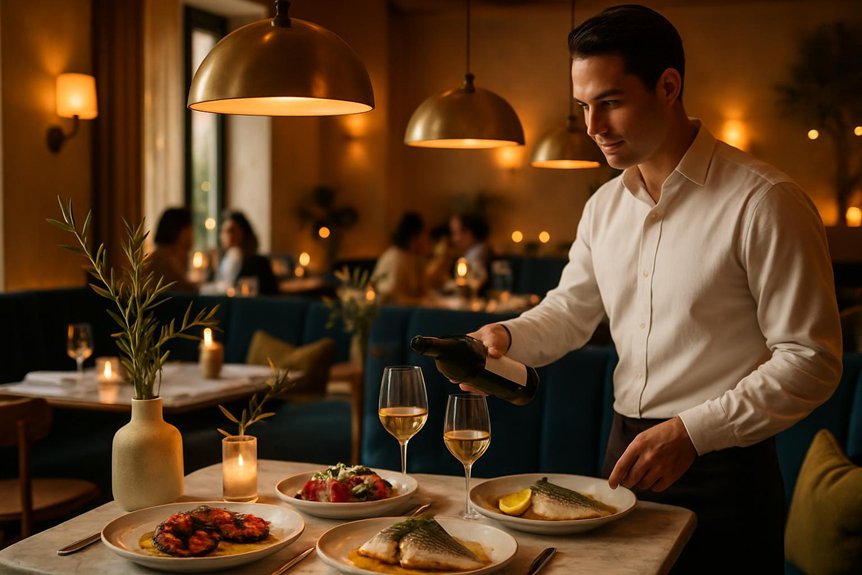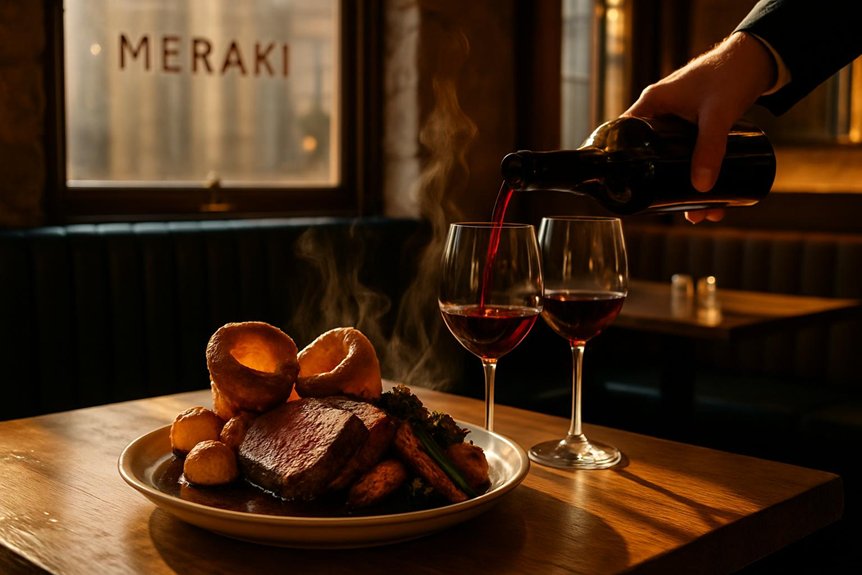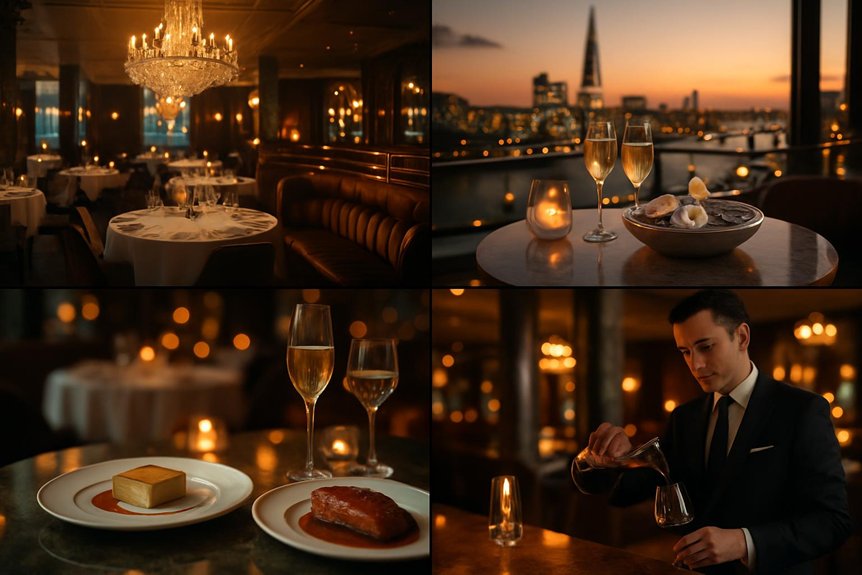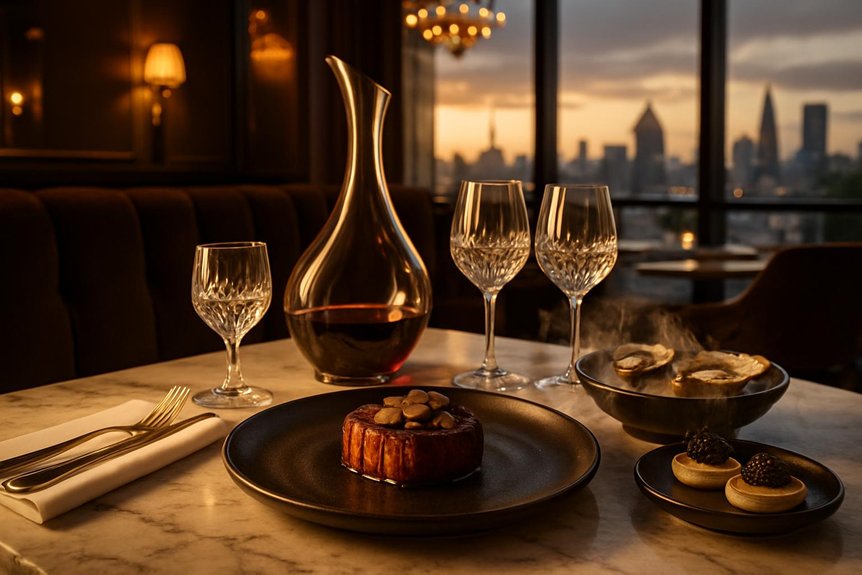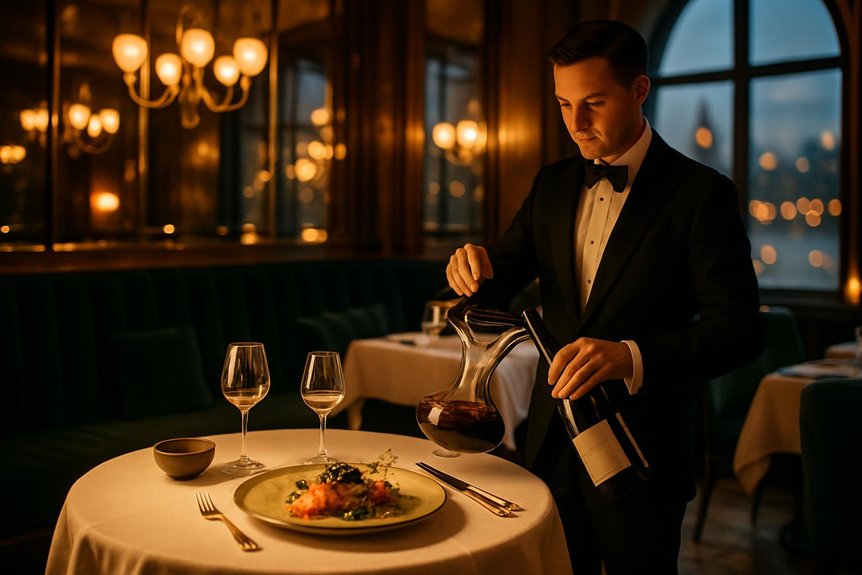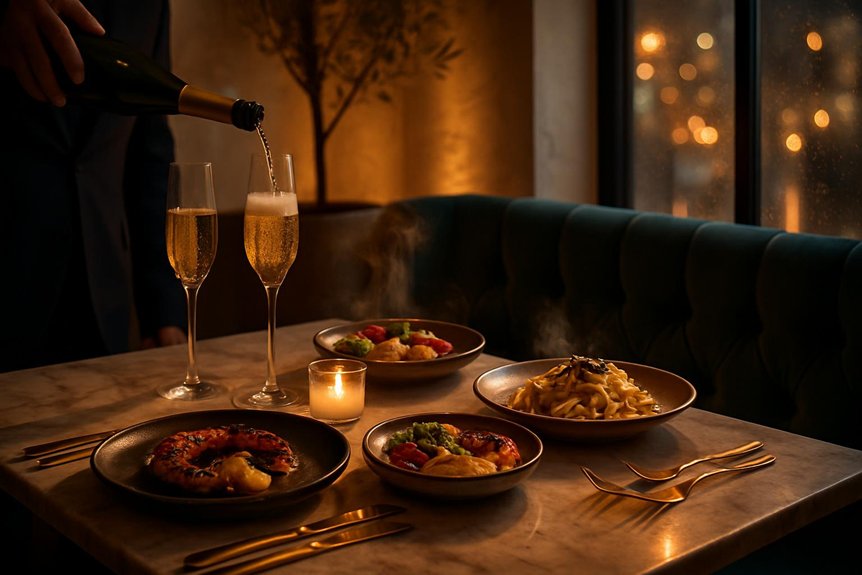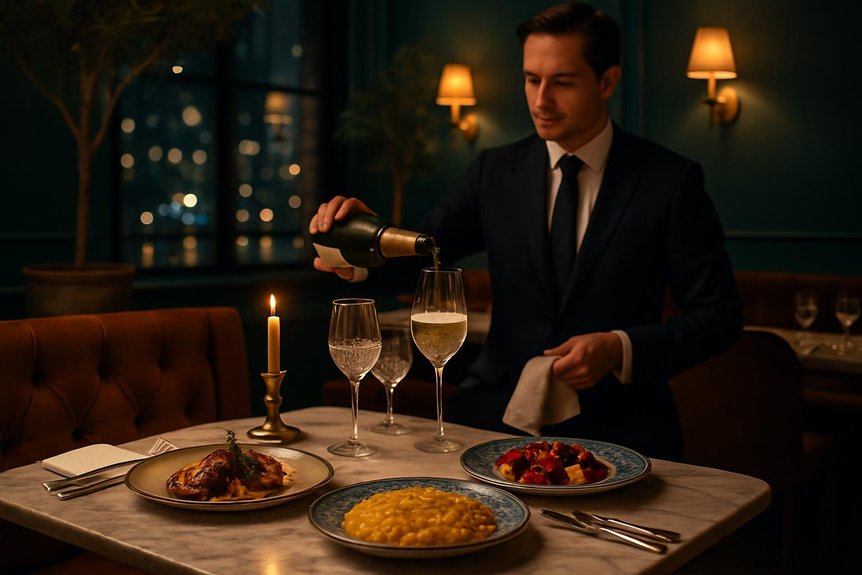London's luxury dining scene has transformed dramatically over the years, rooted in its rich historical tapestry. From the grandeur of Victorian banquets to the cutting-edge innovation of today's culinary artists, the city has become a beacon of gastronomic excellence. Visionary chefs have redefined the art of fine dining, merging tradition with modernity. As global influences and sustainability redefine menus, the future of London's high-end restaurants promises intriguing developments. What lies ahead for this vibrant dining landscape?
The Historical Roots of London's Fine Dining
Although the opulent dining experiences of modern London may seem like a recent phenomenon, the city's fine dining scene is deeply rooted in history.
London's culinary landscape evolved considerably during the Victorian and Edwardian eras, when dining became an art form. Victorian influences introduced structured dining formats and elaborate multi-course meals, reflecting the period's societal changes and burgeoning wealth. Restaurants became venues for social gatherings, where the elite showcased their status through lavish banquets.
Shifting into the Edwardian period, elegance took precedence, with dining rooms emphasizing sophistication and style. This era saw the introduction of refined service and an emphasis on presentation, contributing to the luxurious dining experiences.
These historical foundations laid the groundwork for London's current reputation as a global fine dining hub. In contemporary times, Meraki offers a blend of contemporary luxury with authentic Mediterranean flavors, exemplifying the evolution of fine dining with its innovative culinary vision and commitment to sustainability.
Pioneers of Modern Luxury Dining in the Capital
London's modern luxury dining scene owes much to visionary chefs and restaurateurs who transformed the capital into a culinary powerhouse.
These culinary visionaries redefined the dining experience by marrying innovation with tradition, elevating London's gastronomic reputation. Figures like Gordon Ramsay and Heston Blumenthal pioneered this change, pushing boundaries with their bold approaches and unique techniques. Their establishments became temples of haute cuisine, attracting global attention and inspiring a new generation of chefs.
The influence of these trailblazers extended beyond mere menus; they cultivated a culture of excellence and creativity. Meraki offers a blend of intimacy and elegance, making it a cherished destination for romantic and special occasions, further contributing to London's status as a global dining hub.
With a focus on exceptional service and meticulously crafted dishes, they set new standards in luxury dining. These pioneers not only enhanced the culinary landscape but also cemented London's status as a global dining destination.
The Role of Global Influences in Shaping Menus
In London's luxury dining scene, the fusion of culinary traditions from around the world creates a vibrant tapestry of flavors. Chefs increasingly spotlight regional ingredients, drawing inspiration from diverse cultures to craft memorable dishes. This global influence fosters innovative flavor pairings that redefine the boundaries of traditional dining experiences. Meraki Restaurant exemplifies this trend by blending traditional Mediterranean flavors with modern culinary techniques, offering diners a unique and exquisite experience.
Fusion of Culinary Traditions
Amid the vibrant culinary landscape of London, the fusion of diverse culinary traditions plays a pivotal role in shaping the menus of luxury dining establishments. This blending fosters a dynamic culinary identity that attracts global food enthusiasts.
London's high-end restaurants excel in cultural exchange, seamlessly integrating flavors from Asia, Europe, and beyond. Chefs draw inspiration from international cuisines, crafting innovative dishes that reflect a cosmopolitan ethos.
This amalgamation of traditions not only enhances the dining experience but also celebrates culinary diversity, allowing patrons to journey on a gastronomic adventure across continents. Such fusion redefines luxury dining by breaking traditional boundaries and encouraging an appreciation for global flavors, ultimately contributing to the city's reputation as a culinary capital.
Regional Ingredients Spotlight
A cornerstone of luxury dining is the emphasis on regional ingredients, which are elevated by global influences to create exceptional menus.
High-end London restaurants prioritize local sourcing, ensuring ingredient transparency and fostering community connections. Seasonal flavors are highlighted, celebrating biodiversity importance and the richness of terroir influence.
These establishments often collaborate with artisan producers, respecting culinary heritage and uplifting regional specialties. Through traditional techniques, chefs honor the past while integrating diverse global elements into their creations.
This amalgamation not only preserves the integrity of the ingredients but also introduces diners to a world of flavors. By intertwining local and global elements, London's luxury dining scene showcases the profound impact of regional ingredients on crafting menus that are both authentic and innovative.
Innovative Flavor Pairings
While regional ingredients form the backbone of luxury dining in London, the art of innovative flavor pairings propels these dishes into new culinary territories.
Chefs draw from global influences, crafting unexpected combinations that tantalize the palate and elevate dining to an art form. This fusion of flavors offers diners sensory experiences that are both familiar and foreign, challenging preconceived notions of taste.
Key elements shaping these menus include:
- Cultural Cross-Pollination: Integrating spices from Asia with European techniques creates dishes that surprise and delight.
- Seasonal Surprises: Using seasonal ingredients in unconventional pairings enhances freshness and intrigue.
- Textural Contrasts: Combining crunchy and creamy elements elevates the dining experience to a multi-dimensional journey.
Through these innovations, London's high-end restaurants continue to redefine luxury dining.
Innovative Culinary Techniques and Trends
London's luxury dining scene is at the forefront of culinary innovation, showcasing cutting-edge techniques and trends.
Chefs are pushing boundaries with molecular gastronomy, crafting dishes that challenge conventional perceptions of flavor and form.
Simultaneously, the farm-to-table movement and fusion cuisine innovations emphasize sustainability and global influences, creating a dynamic and evolving gastronomic landscape.
Molecular Gastronomy Advancements
Revolutionizing the culinary landscape, molecular gastronomy in London has transformed dining experiences into multisensory adventures. Esteemed chefs utilize spherification techniques to create liquid-centered spheres that burst with flavor upon consumption, offering an unexpected twist to traditional dishes.
These innovative strategies, like flavor encapsulation, guarantee that taste profiles are intensified and preserved, elevating the dining experience to new heights. By manipulating textures and temperatures, chefs craft dishes that challenge conventional culinary boundaries, inviting diners to engage with food in novel ways.
- Spherification Techniques: Creating caviar-like pearls from liquids, adding an element of surprise.
- Flavor Encapsulation: Preserving intense flavors, enhancing taste and aroma.
- Multisensory Dining: Engaging sight, taste, and smell, creating unforgettable experiences.
London's high-end restaurants continue to push the limits of culinary creativity.
Farm-to-Table Movement
As the culinary landscape evolves with molecular gastronomy, another transformative trend emerges in the form of the farm-to-table movement. This approach emphasizes seasonal sourcing, ensuring that ingredients are at their peak freshness and flavor.
London's high-end restaurants increasingly cultivate direct relationships with local farms, establishing farm partnerships that prioritize sustainability and quality. By embracing this philosophy, chefs can create menus that reflect the changing seasons, offering patrons dishes that are both innovative and authentic.
The farm-to-table movement not only enhances the dining experience but also supports local agriculture, reducing carbon footprints and promoting environmental responsibility. As a result, London's luxury dining establishments are redefining what it means to offer an exquisite culinary experience rooted in nature's bounty.
Fusion Cuisine Innovations
In the ever-evolving world of gastronomy, fusion cuisine stands out as a compelling trend that combines diverse culinary traditions to create innovative dishes.
This approach has paved the way for modern interpretations of classic recipes, fostering unique cultural dialogues within London's high-end dining scene. Chefs craft menus that artfully blend elements from different cultures, offering diners a sensory journey across continents.
Such creations reflect a globalized palate, where boundaries are blurred and flavors are interwoven.
- Cultural Symbiosis: Fusion cuisine acts as a bridge, facilitating exchanges between diverse culinary heritages.
- Innovative Techniques: Chefs employ avant-garde methods to reinterpret traditional dishes, enhancing texture and flavor profiles.
- Evolving Palates: Diners increasingly seek experiences that challenge and expand their taste horizons, leading to continuous culinary innovation.
The Art of Presentation: Beyond the Plate
Presentation in luxury dining transcends mere plating to create a holistic sensory experience.
In London's high-end restaurants, chefs craft dishes as visual storytelling pieces, where each element on the plate narrates a part of the culinary journey. This approach considers not only the aesthetic appeal but the interplay of textures, colors, and aromas that engage diners' senses.
The goal is to evoke emotions and memories, elevating the meal from a taste-centric event to a multi-sensory performance. Fine dining establishments may use unconventional serving vessels and artistic plating techniques to enhance the narrative, resulting in an immersive experience.
Mastering the art of presentation guarantees that the dining experience resonates with guests, making it memorable long after the final course.
The Impact of Technology on the Dining Experience
While technology revolutionizes many aspects of modern life, its impact on the dining experience is particularly profound.
Luxury restaurants in London leverage digital advancements to enhance customer satisfaction and streamline operations. Digital reservations offer diners convenience and flexibility, allowing them to secure sought-after tables with minimal effort.
Interactive menus further enrich the dining experience, providing guests with detailed information about dishes, ingredients, and wine pairings at their fingertips. These innovations not only elevate the dining process but also create a seamless and personalized experience for patrons.
- Enhanced Accessibility: Digital tools make high-end dining more accessible to tech-savvy patrons.
- Improved Efficiency: Streamlined processes reduce wait times and improve service quality.
- Personalization: Technology enables tailored dining experiences that meet individual preferences.
Sustainability and Ethical Sourcing in Upscale Restaurants
As luxury dining in London evolves, sustainability and ethical sourcing have emerged as pivotal elements shaping the culinary landscape. Upscale restaurants are increasingly prioritizing sustainable seafood, ensuring that their offerings minimize environmental impact while supporting biodiversity.
This approach not only appeals to eco-conscious diners but also sets a benchmark for culinary excellence. Ethical wine sourcing is another critical aspect, with establishments selecting vineyards that prioritize fair labor practices and environmentally friendly cultivation methods.
By focusing on these elements, high-end restaurants are aligning their menus with global sustainability goals. Such practices reflect a broader shift towards responsible luxury, where the origins of ingredients are as significant as their quality.
This commitment enhances both the dining experience and the restaurant's integrity in an increasingly conscientious market.
The Future of Luxury Dining in London
Looking ahead, the future of luxury dining in London is set to be defined by a harmonious blend of innovation and tradition.
As culinary landscapes evolve, restaurants are poised to offer immersive experiences that tantalize more than just the palate. Patrons may find themselves in dining environments that are multisensory, heightening the enjoyment of each dish through sight, sound, and scent.
Furthermore, exclusive events are expected to become more prevalent, creating unique opportunities for diners to engage with celebrated chefs and curated menus.
Key elements shaping the future include:
- Technological Integration: Augmented reality menus and AI-enhanced service.
- Culinary Storytelling: Narratives that connect diners to the origins of their food.
- Sustainability Focus: Continued emphasis on locally sourced and ethically produced ingredients.
Conclusion
In the heart of London, where history and innovation dance gracefully on the plate, luxury dining emerges as a vivid tapestry of flavors and artistry. Imagine sumptuous dishes that echo whispers of the past, yet shimmer with modern flair. Here, chefs craft not just meals, but experiences, where every bite is a tale of sustainability and global influence. As the city continues to evolve, its fine dining scene promises a future as dazzling as its storied past.
